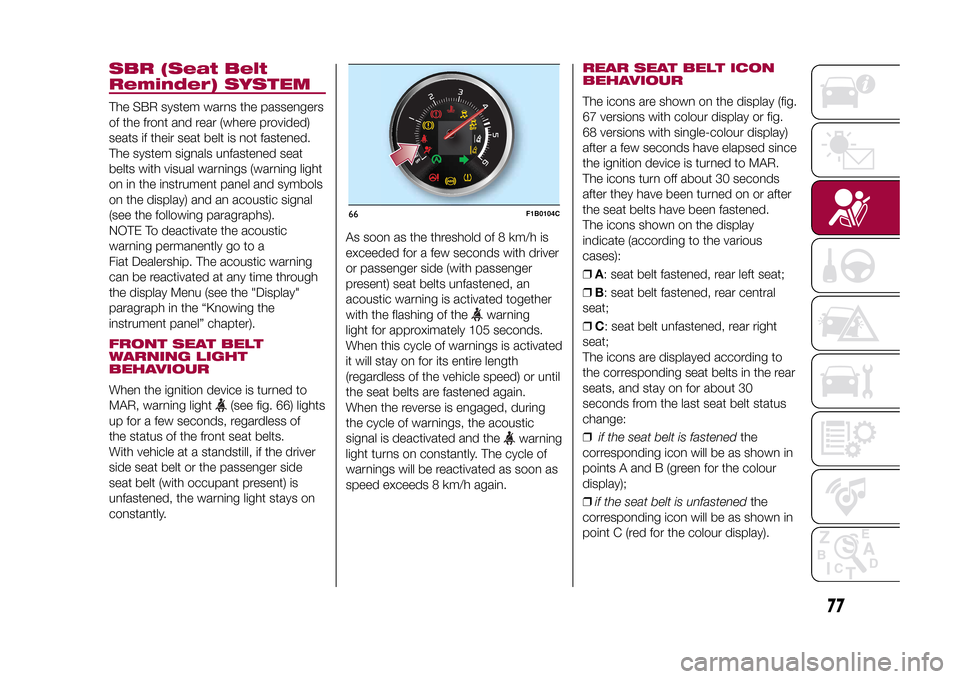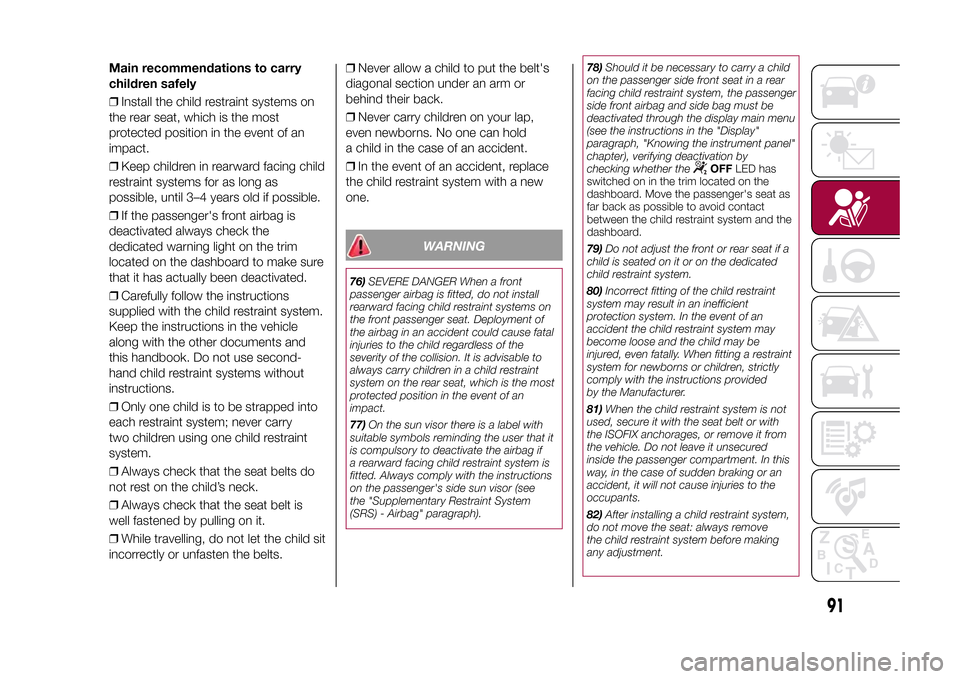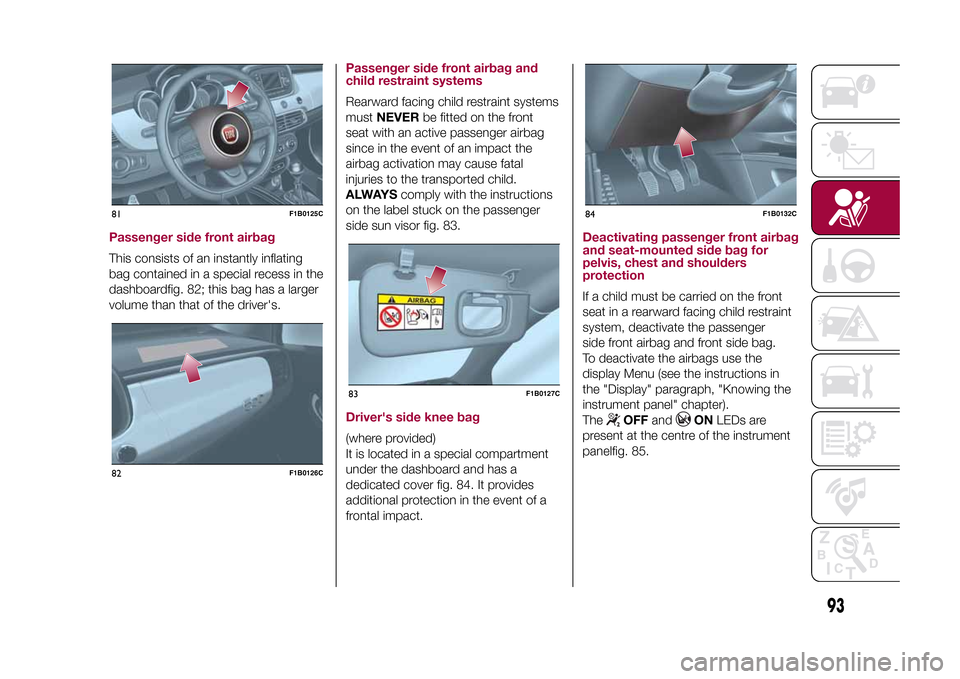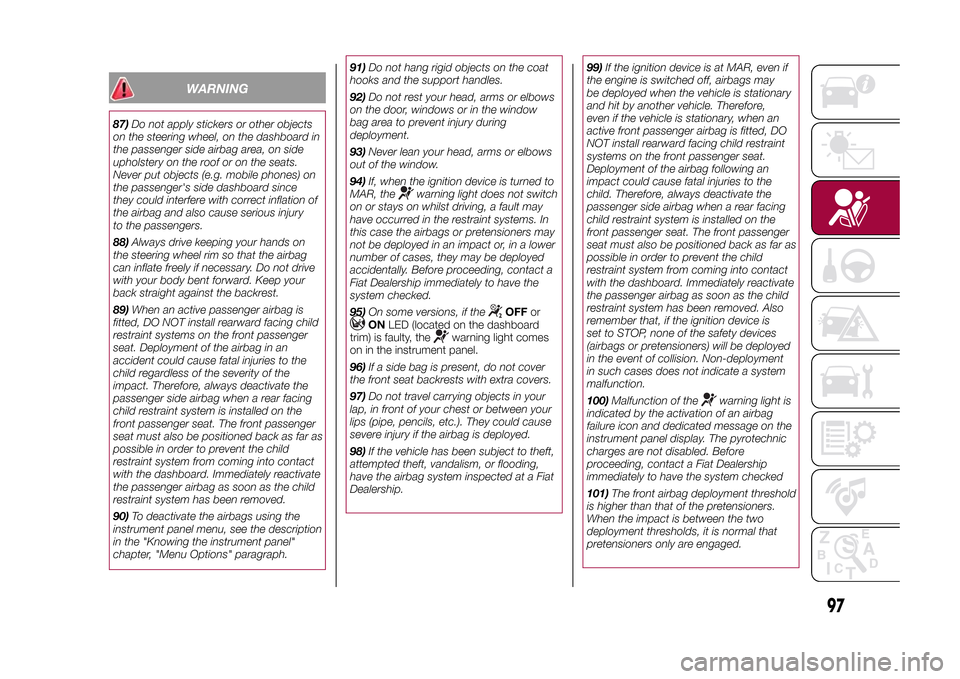2015 FIAT 500X instrument panel
[x] Cancel search: instrument panelPage 74 of 240

Vehicles travelling at right angles to
the vehicleThe system may temporarily react to a
vehicle that is passing through the radar
sensor’s operating range at right angles
fig. 62.
Important❒The system has not been designed
to prevent impacts and cannot detect
possible conditions leading to an
accident in advance. Failure to take into
account this warning may lead to
serious or fatal injuries.
❒The system may activate, assessing
the trajectory of the vehicle, due to
the presence of reflective metal objects
different from other vehicles, such as
safety barriers, road signs, barriers
before parking lots, tollgates, level
crossings, gates, railways, objects near
road constructions sites or higher
than the vehicle (e.g. a flyover). In the
same way, the system may intervene
inside multi-storey car parks or tunnels,
or due to a glare on the road surface.
These possible activations follow the
normal operating logic of the system
and must not be regarded as faults.❒The system has been designed for
road use only. If the vehicle is driven
off-road, the system must be
deactivated, to avoid unnecessary
warnings. Automatic deactivation is
signalled by the dedicated warning
light/icon switching on in the instrument
panel (see the instructions in the
"Warning lights and messages"
paragraph, "Knowing the instrument
panel" chapter).
iTPMS (indirect Tyre
Pressure Monitoring
System)
62) 63) 64) 65) 66) 67)31)
DescriptionThe vehicle can be equipped with the
iTPMS (indirect Tyre Pressure
Monitoring System) which monitors the
tyre inflation status thanks to wheel
speed sensors.Correct tyre pressureIf the pressure of all the tyres
corresponds to the correct value, the
display shows the vehicle with "OK"
beside each wheel.
60
F1B0098C
61
F1B0099C
62
F1B0100C
72
SAFETY
15-12-2014 8:23 Pagina 72
Page 75 of 240

Low tyre pressureThe system warns the driver if one or
more tyres are flat by switching on
the
warning light on the instrument
panel and a warning message on
the display, along with an acoustic
signal. .
If the system does not recognise the
pressure value of one or more tyres, the
display will show dashes "– –"
This indication is displayed also when
turning the engine off and on again until
the RESET procedure is carried out.
Reset procedureThe iTPMS needs an initial "self-
learning" phase (with length depending
on the driving style and road conditions:
optimal conditions being driving on a
straight road at 80 km/h for at least 20
minutes) which starts when the RESET
procedure is carried out.
The RESET procedure must be carried
out:
❒whenever the tyre pressure is
modified;
❒when even only one tyre is changed;
❒when tyres are rotated/inverted;
❒when the space-saver wheel is fitted.Before carrying out the RESET
procedure, inflate the tyres to the rated
pressure values specified in the inflation
pressure table (see "Wheels" paragraph
in the "Technical specifications"
chapter).
If the RESET is not carried out, in all
above cases, the
warning light may
give false indications on one or more
tyres.
To carry out the RESET procedure, with
the vehicle stopped and the ignition
device at MAR, use the Main Menu as
follows:
❒go to "Vehicle info" and then to
"Reset tyre pressure"
❒press the "OK" and hold down (more
than 2 seconds)
❒the display will show the procedure
progress (with a graphic bar) till the
RESET is completed.
At the end of the RESET procedure the
display will show the "Reset saved"
message, indicating that the self-
learning has been started.
Working conditionsThe system is active for speeds above
15 km/h.In a few situations such as sporty
driving, particular conditions of the road
surface (e.g. icy, snowy, unsurfaced
roads...) the signalling may be delayed
or partial in detecting the contemporary
deflation of more than one tyre.
Under special conditions (e.g. vehicle
loaded asymmetrically on one side,
damaged or worn tyre, fitting the
space-saver wheel, fitting snow chains,
fitting different tyres on the axles) the
system may give false indications or be
temporarily deactivated.
If the system is temporarily deactivated
the
warning light flashes for about
75 seconds and then is continuously
on; at the same time, the display shows
a warning message.
This indication is displayed also after
the engine has been switched off and
then on again if the correct operating
conditions are not restored.
WARNING
57)The system is an aid for vehicle driving,
it DOES NOT warn the driver about
incoming vehicles outside of the detection
areas. The driver must always maintain a
sufficient level of attention to the traffic and
road conditions and for controlling the
trajectory of the vehicle.
73
15-12-2014 8:23 Pagina 73
Page 79 of 240

SBR (Seat Belt
Reminder) SYSTEMThe SBR system warns the passengers
of the front and rear (where provided)
seats if their seat belt is not fastened.
The system signals unfastened seat
belts with visual warnings (warning light
on in the instrument panel and symbols
on the display) and an acoustic signal
(see the following paragraphs).
NOTE To deactivate the acoustic
warning permanently go to a
Fiat Dealership. The acoustic warning
can be reactivated at any time through
the display Menu (see the "Display"
paragraph in the “Knowing the
instrument panel” chapter).FRONT SEAT BELT
WARNING LIGHT
BEHAVIOURWhen the ignition device is turned to
MAR, warning light
(see fig. 66) lights
up for a few seconds, regardless of
the status of the front seat belts.
With vehicle at a standstill, if the driver
side seat belt or the passenger side
seat belt (with occupant present) is
unfastened, the warning light stays on
constantly.As soon as the threshold of 8 km/h is
exceeded for a few seconds with driver
or passenger side (with passenger
present) seat belts unfastened, an
acoustic warning is activated together
with the flashing of the
warning
light for approximately 105 seconds.
When this cycle of warnings is activated
it will stay on for its entire length
(regardless of the vehicle speed) or until
the seat belts are fastened again.
When the reverse is engaged, during
the cycle of warnings, the acoustic
signal is deactivated and the
warning
light turns on constantly. The cycle of
warnings will be reactivated as soon as
speed exceeds 8 km/h again.
REAR SEAT BELT ICON
BEHAVIOURThe icons are shown on the display (fig.
67 versions with colour display or fig.
68 versions with single-colour display)
after a few seconds have elapsed since
the ignition device is turned to MAR.
The icons turn off about 30 seconds
after they have been turned on or after
the seat belts have been fastened.
The icons shown on the display
indicate (according to the various
cases):
❒A: seat belt fastened, rear left seat;
❒B: seat belt fastened, rear central
seat;
❒C: seat belt unfastened, rear right
seat;
The icons are displayed according to
the corresponding seat belts in the rear
seats, and stay on for about 30
seconds from the last seat belt status
change:
❒if the seat belt is fastenedthe
corresponding icon will be as shown in
points A and B (green for the colour
display);
❒if the seat belt is unfastenedthe
corresponding icon will be as shown in
point C (red for the colour display).
66
F1B0104C
77
15-12-2014 8:23 Pagina 77
Page 93 of 240

Main recommendations to carry
children safely
❒Install the child restraint systems on
the rear seat, which is the most
protected position in the event of an
impact.
❒Keep children in rearward facing child
restraint systems for as long as
possible, until 3–4 years old if possible.
❒If the passenger's front airbag is
deactivated always check the
dedicated warning light on the trim
located on the dashboard to make sure
that it has actually been deactivated.
❒Carefully follow the instructions
supplied with the child restraint system.
Keep the instructions in the vehicle
along with the other documents and
this handbook. Do not use second-
hand child restraint systems without
instructions.
❒Only one child is to be strapped into
each restraint system; never carry
two children using one child restraint
system.
❒Always check that the seat belts do
not rest on the child’s neck.
❒Always check that the seat belt is
well fastened by pulling on it.
❒While travelling, do not let the child sit
incorrectly or unfasten the belts.❒Never allow a child to put the belt's
diagonal section under an arm or
behind their back.
❒Never carry children on your lap,
even newborns. No one can hold
a child in the case of an accident.
❒In the event of an accident, replace
the child restraint system with a new
one.
WARNING
76)SEVERE DANGER When a front
passenger airbag is fitted, do not install
rearward facing child restraint systems on
the front passenger seat. Deployment of
the airbag in an accident could cause fatal
injuries to the child regardless of the
severity of the collision. It is advisable to
always carry children in a child restraint
system on the rear seat, which is the most
protected position in the event of an
impact.
77)On the sun visor there is a label with
suitable symbols reminding the user that it
is compulsory to deactivate the airbag if
a rearward facing child restraint system is
fitted. Always comply with the instructions
on the passenger's side sun visor (see
the "Supplementary Restraint System
(SRS) - Airbag" paragraph).78)Should it be necessary to carry a child
on the passenger side front seat in a rear
facing child restraint system, the passenger
side front airbag and side bag must be
deactivated through the display main menu
(see the instructions in the "Display"
paragraph, "Knowing the instrument panel"
chapter), verifying deactivation by
checking whether the
OFFLED has
switched on in the trim located on the
dashboard. Move the passenger's seat as
far back as possible to avoid contact
between the child restraint system and the
dashboard.
79)Do not adjust the front or rear seat if a
child is seated on it or on the dedicated
child restraint system.
80)Incorrect fitting of the child restraint
system may result in an inefficient
protection system. In the event of an
accident the child restraint system may
become loose and the child may be
injured, even fatally. When fitting a restraint
system for newborns or children, strictly
comply with the instructions provided
by the Manufacturer.
81)When the child restraint system is not
used, secure it with the seat belt or with
the ISOFIX anchorages, or remove it from
the vehicle. Do not leave it unsecured
inside the passenger compartment. In this
way, in the case of sudden braking or an
accident, it will not cause injuries to the
occupants.
82)After installing a child restraint system,
do not move the seat: always remove
the child restraint system before making
any adjustment.
91
15-12-2014 8:23 Pagina 91
Page 95 of 240

Passenger side front airbagThis consists of an instantly inflating
bag contained in a special recess in the
dashboardfig. 82; this bag has a larger
volume than that of the driver's.
Passenger side front airbag and
child restraint systemsRearward facing child restraint systems
mustNEVERbe fitted on the front
seat with an active passenger airbag
since in the event of an impact the
airbag activation may cause fatal
injuries to the transported child.
ALWAYScomply with the instructions
on the label stuck on the passenger
side sun visor fig. 83.Driver's side knee bag(where provided)
It is located in a special compartment
under the dashboard and has a
dedicated cover fig. 84. It provides
additional protection in the event of a
frontal impact.
Deactivating passenger front airbag
and seat-mounted side bag for
pelvis, chest and shoulders
protectionIf a child must be carried on the front
seat in a rearward facing child restraint
system, deactivate the passenger
side front airbag and front side bag.
To deactivate the airbags use the
display Menu (see the instructions in
the "Display" paragraph, "Knowing the
instrument panel" chapter).
The
OFFand
ONLEDs are
present at the centre of the instrument
panelfig. 85.
81
F1B0125C
82
F1B0126C
83
F1B0127C
84
F1B0132C
93
15-12-2014 8:23 Pagina 93
Page 99 of 240

WARNING
87)Do not apply stickers or other objects
on the steering wheel, on the dashboard in
the passenger side airbag area, on side
upholstery on the roof or on the seats.
Never put objects (e.g. mobile phones) on
the passenger's side dashboard since
they could interfere with correct inflation of
the airbag and also cause serious injury
to the passengers.
88)Always drive keeping your hands on
the steering wheel rim so that the airbag
can inflate freely if necessary. Do not drive
with your body bent forward. Keep your
back straight against the backrest.
89)When an active passenger airbag is
fitted, DO NOT install rearward facing child
restraint systems on the front passenger
seat. Deployment of the airbag in an
accident could cause fatal injuries to the
child regardless of the severity of the
impact. Therefore, always deactivate the
passenger side airbag when a rear facing
child restraint system is installed on the
front passenger seat. The front passenger
seat must also be positioned back as far as
possible in order to prevent the child
restraint system from coming into contact
with the dashboard. Immediately reactivate
the passenger airbag as soon as the child
restraint system has been removed.
90)To deactivate the airbags using the
instrument panel menu, see the description
in the "Knowing the instrument panel"
chapter, "Menu Options" paragraph.91)Do not hang rigid objects on the coat
hooks and the support handles.
92)Do not rest your head, arms or elbows
on the door, windows or in the window
bag area to prevent injury during
deployment.
93)Never lean your head, arms or elbows
out of the window.
94)If, when the ignition device is turned to
MAR, the
warning light does not switch
on or stays on whilst driving, a fault may
have occurred in the restraint systems. In
this case the airbags or pretensioners may
not be deployed in an impact or, in a lower
number of cases, they may be deployed
accidentally. Before proceeding, contact a
Fiat Dealership immediately to have the
system checked.
95)On some versions, if the
OFFor
ONLED (located on the dashboard
trim) is faulty, the
warning light comes
on in the instrument panel.
96)If a side bag is present, do not cover
the front seat backrests with extra covers.
97)Do not travel carrying objects in your
lap, in front of your chest or between your
lips (pipe, pencils, etc.). They could cause
severe injury if the airbag is deployed.
98)If the vehicle has been subject to theft,
attempted theft, vandalism, or flooding,
have the airbag system inspected at a Fiat
Dealership.99)If the ignition device is at MAR, even if
the engine is switched off, airbags may
be deployed when the vehicle is stationary
and hit by another vehicle. Therefore,
even if the vehicle is stationary, when an
active front passenger airbag is fitted, DO
NOT install rearward facing child restraint
systems on the front passenger seat.
Deployment of the airbag following an
impact could cause fatal injuries to the
child. Therefore, always deactivate the
passenger side airbag when a rear facing
child restraint system is installed on the
front passenger seat. The front passenger
seat must also be positioned back as far as
possible in order to prevent the child
restraint system from coming into contact
with the dashboard. Immediately reactivate
the passenger airbag as soon as the child
restraint system has been removed. Also
remember that, if the ignition device is
set to STOP, none of the safety devices
(airbags or pretensioners) will be deployed
in the event of collision. Non-deployment
in such cases does not indicate a system
malfunction.
100)Malfunction of the
warning light is
indicated by the activation of an airbag
failure icon and dedicated message on the
instrument panel display. The pyrotechnic
charges are not disabled. Before
proceeding, contact a Fiat Dealership
immediately to have the system checked
101)The front airbag deployment threshold
is higher than that of the pretensioners.
When the impact is between the two
deployment thresholds, it is normal that
pretensioners only are engaged.
97
15-12-2014 8:23 Pagina 97
Page 102 of 240

STARTING THE
ENGINEBefore starting the engine, adjust the
seat, the interior rear view mirrors,
the door mirrors and fasten the seat
belt correctly.
Never press the accelerator pedal for
starting the engine.
If necessary, messages indicating the
starting procedure can be shown on
the display.ENGINE STARTING
PROCEDURE
103) 104) 105) 106)33) 34) 35) 36)
Versions with manual gearboxProceed as follows:
❒engage the electric parking brake
and place the gear lever in neutral;
❒bring the ignition device to MAR. On
Diesel versions, warning light
lights up in the instrument panel:
wait for the warning light to switch off;
❒fully depress the clutch pedal without
touching the accelerator;
❒turn the ignition device to AVV and
release it as soon as the engine starts;❒if the engine does not start within 10
seconds, bring the ignition device
back to STOP and wait for 10-15
seconds before repeating the starting
procedure.
❒after the manoeuvre has been
repeated, if the problem persists,
contact a Fiat Dealership.
Versions with automatic
transmissionProceed as follows:
❒engage
the electric parking brake
and set the gear lever to P (Park) or N
(Neutral);
❒fully depress the brake pedal without
touching the accelerator;
❒set the ignition device to AVV;
❒if the engine does not start, bring the
ignition device back to STOP and
wait for 10-15 seconds before
repeating the starting procedure;
❒after the manoeuvre has been
repeated, if the problem persists,
contact a Fiat Dealership.
ENGINE STARTING
F
AILURE
Starting the engine with electronic
key battery (Keyless Go) run down
or flatIf the ignition device does not respond
when the relevant button is pressed the
electronic key battery might be run
down or flat. Therefore, the system
does not detect the presence of the
electronic key on board the vehicle and
displays a dedicated message. In this
case, rest the rounded edge of the
electronic key (the side opposite the
metal insert) on the ignition device and
press the button using the electronic
key. The ignition device is thus
activated and the engine can be
started.
WARNING
103)Do not try to start the engine by
pouring fuel or other flammable fluid inside
the throttle body air intake: this might
damage the engine and injury people
nearby.
104)It is dangerous to run the engine in
enclosed areas. The engine consumes
oxygen and produces carbon dioxide,
carbon monoxide and other toxic gases.
105)The brake servo is not operational
until the engine has been started; therefore
you need to apply much more force than
usual to the brake pedal.
100
STARTING AND DRIVING
12-1-2015 15:6 Pagina 100
Page 104 of 240

A slight movement of the brake pedal
may be detected when engaging the
electric parking brake with the brake
pedal pressed.
With the electric parking brake
engaged, the
warning light on the
instrument panel and the LED on the
switch fig. 89 turn on.
IMPORTANT With the EPB failure
warning light on, some functions of the
electric parking brake are deactivated.
In this case the driver is responsible
for brake activation and vehicle parking
in complete safety conditions.
If, under exceptional circumstances, the
use of the parking brake is required
with the vehicle in motion, keep the
switch on the central tunnel pulled as
long as the brake action is necessary.
The
warning light may switch
on with the hydraulic system
temporarily unavailable; in this case
braking is controlled by the motors.
The brake lights (stop) also come
on automatically.
Release the switch on the central tunnel
to stop the braking action with the
vehicle in motion.
If, through this procedure, the vehicle is
braked until a speed below 3 km/h is
reached and the switch is kept pulled,
the parking brake will definitively
engage.IMPORTANT Driving the vehicle with
the electric parking brake engaged, or
using it several times to slow down
the vehicle, may cause severe damage
to the braking system.
Disengaging the electric parking
brake
manuallyTo manually disengage the parking
brake, the ignition device must be at
MAR. It is also necessary to press the
brake pedal, then briefly press the
fig. 89 switch.
Noise may be heard from the rear of the
vehicle and a slight movement of the
brake pedal may be detected during
disengagement.
After disengaging the electric parking
brake, the warning light
on the
instrument panel and the LED on the
switch turn off.
If the
warning light on the
instrument panel remains on with the
electric parking brake disengaged, this
indicates a fault: in this case contact
a Fiat Dealership.IMPORTANT On versions with
automatic transmission never use the P
(Park) position instead of the electric
parking brake. Always engage the
electric parking brake when parking the
vehicle to prevent injury or damage
caused by the unexpected movement
of the vehicle.
IMPORTANT For vehicles equipped
with manual gearbox, if the clutch pedal
is released simultaneously with the
press of the accelerator, the electric
handbrake automatically releases.
ELECTRIC PARKING
BRAKE
OPERATING
MODESThe electric parking brake may operate
as follows:
❒"Dynamic operating mode": this
mode is activated by pulling the fig. 89
switch repeatedly whilst driving;
❒"Static engagement and release
mode": with the vehicle stationary, the
electric parking brake can be activated
by pulling the switch once. On the other
hand, press the switch and the brake
pedal at the same time to disengage
the brake;
102
STARTING AND DRIVING
12-1-2015 15:6 Pagina 102